Euro Bank Notes
Although my site is about Euro Coins, I assume many who are interested in the coins will also have an interest in peripheral issues such as Euro Bank Notes, paper money value, events leading to the introduction of the Euro, countries intending/wanting/waiting to enter the Eurozone etc. and so you have here a page with a few particulars pertaining to Euro Notes.
You will notice that the images displayed all have "specimen" printed across them. Because of the problem of forgery it is difficult to obtain permission to display "clean" images but for the purposes of the page the images displayed are, I think, adequate.
All of the Euro Bank Notes have different versions of the following themes:
- Front side: Windows and Gateways which are supposed to symbolize the European spirit of openness and cooperation.
- Reverse Side: Bridges which are supposed to symbolize communication between the people of Europe as well as between Europe and the rest of the world.
The images are deliberately designed not to represent any actual structures and are thus not country specific. The differences between the various designs are in the type of style.
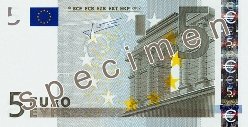
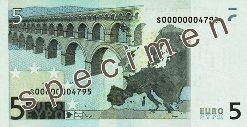
5 Euro Note - represents a Classical Architectural Style
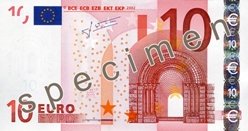
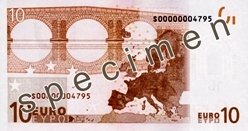
10 Euro Note - represents a Romanesque Architectural Style
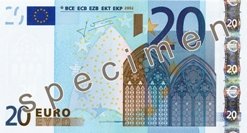
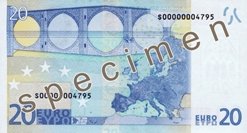
20 Euro Note - represents a Gothic Architectural Style
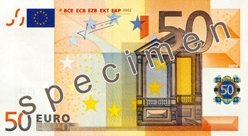
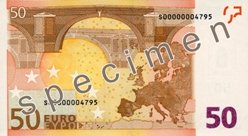
50 Euro Note - represents a Renaissance Architectural Style
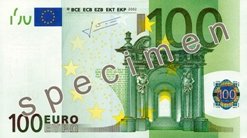
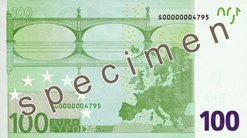
100 Euro Note - represents a Baroque/Rococo Architectural Style
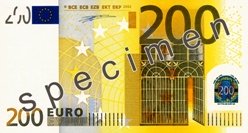
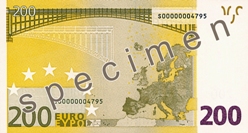
200 Euro Note - represents an Art Noveau Architectural Style
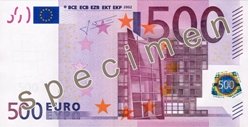
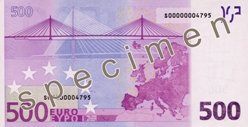
500 Euro Note - represents a Modern Architectural Style
Further features:
- The 12 stars of the EU are shown on all of the notes.
- The initials for the European Central Bank appear in 5 different forms: BCE,ECB,EZB,EKTand EKD.These forms cover all of the 11 offocial languages of the EU.
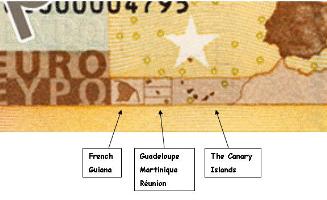
- A map of Europe is shown. In the left of the bottom bar on the reverse side are some boxes in which are depicted the various overseas territories that have the Euro as their official currency. See EUROZONE for a full list of these territories.
Signatures.
All Euro Notes bear the signature of the president of the European Central Bank.
You can approximately date your note by comparing the signature on it with those in the following table.
Table showing the Presidents of the European Central Bank, their date of tenure and their signatures.
| President of European Central Bank | Tenure of Presidency | Signature |
| Wim Duissenberg | 01.06.1998 to 31.10.2003 |  |
Jean-Claude Trichet | 01.11.2003 to 31.10.2011 |  |
| Mario Draghi | from 01.11.2011 to present |  |
Two numbers appear on the Euro Notes:
- One is sort of hidden - in the Euro stars on most notes but within a small rectangle to the left of the Euro stars on the 5 Euro Note.
- One is printed boldly (twice) of the reverse side of all notes
Let's consider the first of these. (Plating Number)
This is a 6 character alpha numeric - a letter followed by 3 numerals followed by a letter and finally a numeral.
- The initial letter identifies where the note was printed.
- The following 3 numerals identify the printing plate used.
- The next letter identifies the row on the printing plate.
- The last numeral identfies the column on the printing plate.
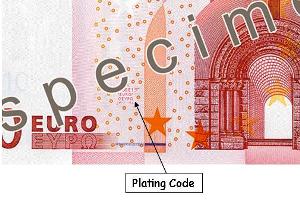
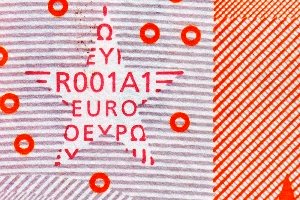
Looking at the image on the left we see that this note (a 10 Euro Note) was printed at location R, that it was printed with the very first plate and that it was at the top left hand corner of the plate - A1 = Row1/Column 1
Now let's consider the second prominently displayed number. (Unique Serial Number)
Each Euro Note has a unique serial number. This is a twelve character alphanumeric with a leading letter followed by 11 numerals.
The leading letter shows for which central bank the note was issued. (National identification Code).
Note: a bank note issued by a specific National Bank could well have been printed in another country.
Table showing the relevance of the Plating Code and National Identification Code letters
| Country | National Identification Code | Plating Code |
Printing Institution |
| Austria | N | F | Österreichische Banknoten und Sicherheitsdruck |
| Belgium | Z | T | Banque Nationale de Belgique |
| Cyprus | G | ||
| Estonia | D | ||
| Finland | L | D | Setec Oy |
| France | U | E | F.C.Oberthur |
| L | Banque de France | ||
| Germany | X | P | Giesecke & Devrient |
| R | Bundesdruckerei | ||
| Greece | Y | R | Bank of Greece |
| Ireland | T | K | Central Bank of Ireland |
| Italy | S | J | Instituto Poligrafico e Zecca dello Stato |
| Luxembourg | R | ||
| Malta | F | ||
| Netherlands | P | G | Koninklijke Joh. Enschede |
| Portugal | M | U | Valora S.A. |
| Slovakia | E | ||
| Slovenia | H | ||
| Spain | V | M | Fábrica Nacional de Moneda y Timbre |
From the above table you will see that some countries - France and Germany use two different printers while other countries - e.g. Luxembourg and Malta - do not print any notes.
The design of the Euro Notes ( as with the Euro Coins) was completed after consultation with organizations representing visibly impaired as well as totally blind people.
Features have been incorporated to enable these people to distinguish between the different notes:
- All the denominations are of a different size, increasing in size from the smallest (5 Euro) to the largest (500 Euro).
- Certain features were included to enable those with sensitive fingers to distinguish between the denominations.
Security Features.
The measures taken to thwart the efforts of counterfeiters are legion - at least 30 have been made known by the authorities or discovered by individuals but there are still others the nature of which is kept secret.
To look at these more closely falls outside of the scope of this site but here is a link to an excellent article in Wikipedia which covers the measures against counterfeiting in greater detail and from which I in fact got much of the material for this page.
Return fron Euro Bank Notes to Euro coin Collector.